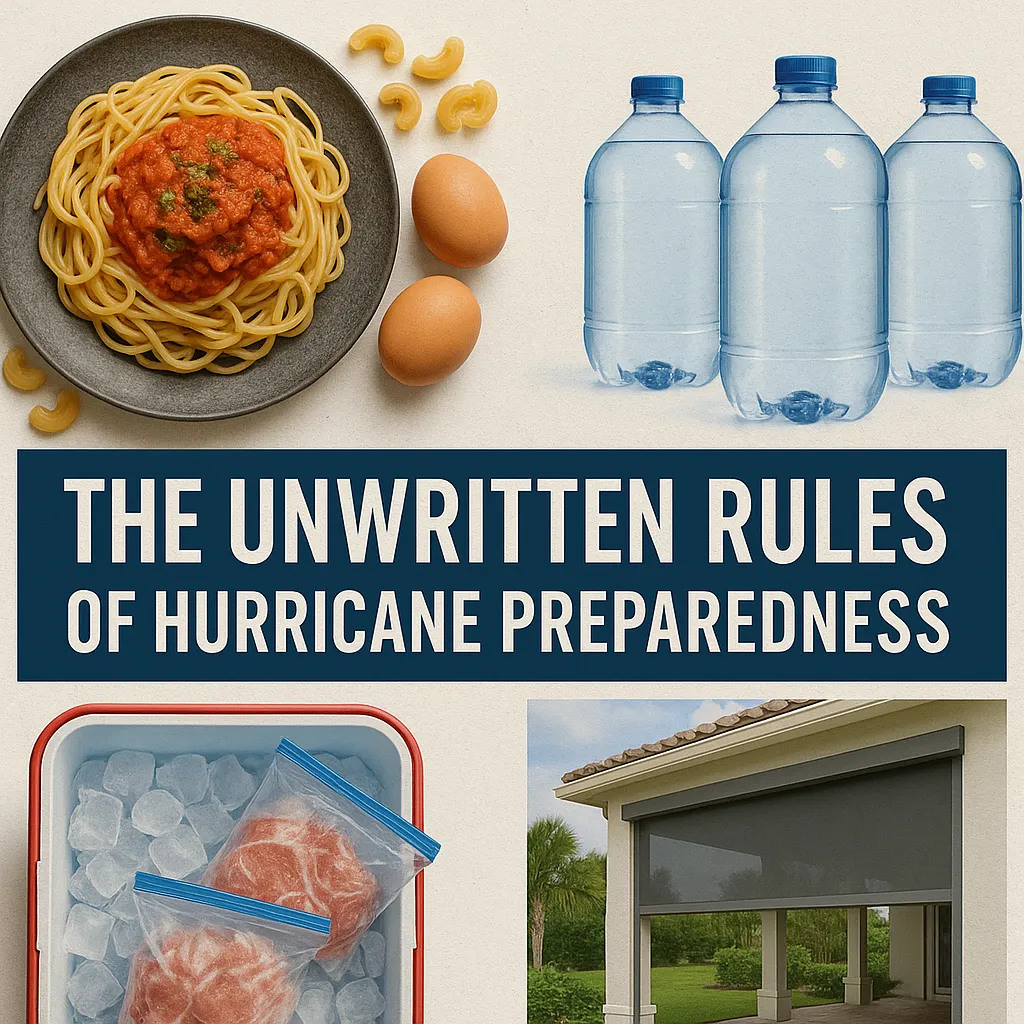
Unwritten Rules To Hurricane Preperation
The Unwritten Rules of Hurricane Preparedness
Hurricanes don’t knock politely. They arrive like uninvited houseguests with a vendetta, kicking in the door and scattering your life across the lawn. Most people meet them armed with the usual list — bottled water, canned goods, flashlights — and while that’s a decent start, it’s like bringing a pocketknife to a sword fight. The real battle is fought in the quiet details, the things you only learn after living through a storm and seeing what breaks first.
In this article, we are going to cover eight unwritten rules and things homeowners often don't think about before, during, and after a hurricane.
Florida Hurricane Kitchen Prep: The Heartbeat That Stops
When the power dies, so does the hum of your refrigerator. It’s like a heartbeat gone still. Every item inside is on a ticking clock, waiting to see who spoils first. This is where having the right hurricane survival food makes all the difference.
Dry pasta is the quiet hero of Florida hurricane preparation — lightweight, long-lasting, and forgiving. With nothing more than boiling water, it becomes comfort on a plate. Elbows for mac and cheese when nerves are frayed. Penne with jarred marinara when you need something that feels like normal life. Chili mac when protein and warmth matter more than presentation. Each recipe is a five-minute act of resilience, and with a camp stove or Dutch oven, the show always goes on.
Then there are eggs. But not the store-bought, refrigerated ones that panic buyers grab before every storm. The real prize? Eggs from a local farm like Black Hammock Farms, still wearing their natural “bloom.” That invisible coating acts like armor, keeping them fresh at room temperature for up to two weeks and in the fridge for as long as three months (Simply Recipes). They’re small, oval insurance policies against the creeping hunger of a prolonged outage.
Cooler Food Storage After a Hurricane: Your Temporary Fortress
When the fridge is down, a cooler becomes the fortress wall between your food and the slow siege of Florida heat. But a cooler is stingy with its space — every inch counts.
The USDA’s own guidance is simple: fill it with two parts ice to one part food (USDA). Block ice works best, melting slower like a stubborn old guard refusing to leave his post. Meats belong in sealed zip-top bags, exiled to the bottom so their juices don’t contaminate the rest. Empty air is a thief of cold, so fill every gap with towels or frozen bottles. Managed right, a shaded cooler can keep food safe for 24–48 hours. Managed poorly, and you’ll be standing in a parking lot paying double for ice before the week is out.
Hurricane Water Storage: The Quiet Emergency
Storm water is a liar — it pours from the sky, floods the streets, and yet not a drop is safe to drink. That’s why you create your own supply before the first gust shakes the palm trees.
Keep two 2.5-gallon jugs sealed and ready — they don’t expire (USDA Blog). Freeze gallon-sized bags of water for ice and later drinking water. Fill the bathtub for utility water — cleaning, flushing, and surviving. It’s not romantic, but it’s how you keep your home running as an island when the grid goes dark.
Bartering After a Hurricane: The Currency of Crisis
When the power’s out, the ATMs are down, and the gas station’s sign reads “cash only” — if they’re open at all — money starts to feel like Monopoly bills. What matters is what you have, not what’s in your account.
Here at Florida Living Outdoor, we don’t drink — and we sure don’t recommend getting intoxicated before, during, or after a storm. But we’ve been around long enough to know this: you’d be surprised how far a case of Bud Light can go when trading for gas, ice, or a favor you really need. It’s not about the beer — it’s about having something someone else values when they can’t just go buy it.
The same goes for unexpected comfort items. A couple extra bags of charcoal can mean the difference between a cold dinner and a hot meal for someone else. A sleeve of cookies can light up a kid’s face — and earn you a neighbor who’s more than willing to share their last bag of ice.
Bartering isn’t about greed. It’s about goodwill, reciprocity, and being part of a storm-hardened network. Keep a small “trade stash” tucked away:
Non-perishable comfort foods
Spare bags of charcoal or propane canisters
Bottled drinks or sports beverages
Sealed snacks (cookies, crackers, nuts)
When the wind stops howling, it’s not just supplies that get you through — it’s relationships. And sometimes, a sleeve of Oreos is worth its weight in diesel.
Hurricane Aftermath Survival: The Part Most People Miss
Here’s the truth: most people stop prepping when they feel “ready.” But the storm is only the prologue. The aftermath is where the real hardship lives. Between 1988 and 2019, more than 18,000 hurricane-related deaths occurred after the storm had passed, according to an Associated Press analysis. Heat, infection, food spoilage, medical isolation — the quiet killers that don’t make the evening news.
Fuel Storage for Hurricane Season: The Lifeblood of Your Post-Storm World
Your generator is a hungry beast. At full load, a 5 kW model drinks about 18 gallons a day (Assurance Power). Three to five days’ worth of fuel is the bare minimum, but if supply chains are choked, you’ll want more. Add a fuel stabilizer and store it in approved metal cans — ideally the kind you order online in the off-season, before prices spike and store shelves empty.
Gas isn’t just for electricity. It’s for running fans when the air turns to soup, for keeping medicine cold, for turning your home from a shelter back into a place to live.
Generator Safety During Hurricanes: The Breath You Can’t See
Picture this: the storm has passed, but the world outside still feels gutted. Your kids are cross-legged on the floor, faces lit by their tablets, the steady growl of a generator somewhere nearby. It feels like a small victory — until you remember generators exhale a breath you can’t see: carbon monoxide.
After Hurricane Ike, three out of every four children treated for CO poisoning were simply playing video games powered by portable generators (Poison Control). In New York State, research found that just four hours without power increased the odds of a child ending up in the ER for CO poisoning by 50%, and in large-scale outages, by 150% (PubMed).
The fix? Keep fully charged battery packs for every family member’s devices. They buy you hours — even days — of peace without ever having to run a generator near living spaces. This is one rule where cutting corners can cost lives — so don’t.
MagnaTrack Defender Hurricane Screens: The Button That Buys You Time
And then there’s the thing most people never consider — the button. If you’ve got a MagnaTrack Motorized Screen System, by Progressive Screens, hurricane prep becomes a press-and-done job. You drop the screens, and your patio transforms into a bunker for your furniture, grill, and anything else the wind might claim. Cleanup shrinks from hours to minutes. Shade and privacy return even before the neighborhood does.
It’s not just a screen. It’s the last word in your hurricane story — the part where you’re sitting with coffee, listening to the cicadas, knowing you kept the chaos outside where it belongs.
This article Made Possible By MagnaTrack Motorized Screen System by Florida Living Outdoor

